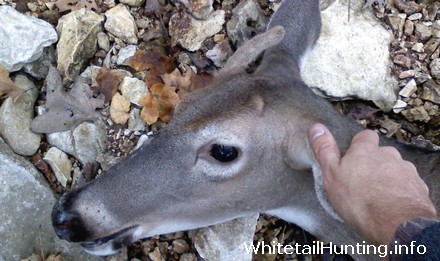Whitetail Deer Hunting Question
Submitted: “This morning my wife and I while whitetail deer hunting saw what we believed to be a hard antlered spike, however upon closer observation (binos) I saw that this deer wasn’t sporting any “junk in the trunk” so to speak. Therefore much to my surprise I figured it to be a doe with hardened antlers. Now I do know that if this deer is harvested it must be tagged as a buck, but I have some questions. What would cause a doe to have antlers? If a doe can have antlers, would shed shed them each year? Would it be possible for her to have fawns?
It was a really cool sight to see. The horns were about 5 to 7 inches long were well polished. Thanks for your help and has anyone else ever witnessed this, a doe with horns? Crazy.”
Whitetail Hunting
Response: All female deer have a small amount of testosterone, which is the hormone commonly associated with males. Additionally, all males have some amount of “female” hormone called estrogen. When the hormone amounts get out of balance and a female ends up with too much testosterone floating around, she can begin to take on male characteristics. The opposite can occur in buck deer. So, a female deer with antlers has more than the normal amount of testosterone, but she is still a female from the inside and out.

The answer to your question is yes, some antlered whitetail does will and can breed and raise fawns if and only if they are able to be bred and can conceive. Although bucks may initially recognize the antlered doe as a buck, I have seen antlered does raise fawns successfully. Estrogen levels will definitely rise even more once she is pregnant.
Not all, but the majority of antlered does remain in velvet year around and do not shed their antlers. This has a very simple explanation: the antler growing cycle is controlled by testosterone levels, which normally cycles annually in whitetail bucks. A bucks hormone levels will rise and fall with the seasons and thus his antlers grow and then fall off as needed.
Antlers are a secondary sexual characteristic in bucks. They do not need antlers to live day-to-day, but they are important for marking and defending breeding areas both before and during the rut. Antlers help bucks battle one another to determine who has rights to breed the does in a given area. A buck only has live sperm when he has hardened antlers, otherwise he is sterile.
In short, a whitetail doe with just enough testosterone in her body to grow antlers will not have enough variation in hormone levels to undergo the various stages on antler growth and loss, so her antlers will stay in the velvet stage and just grow according to the levels of testosterone in her body. Whitetail does can have antlers, but it’s definitely not normal.